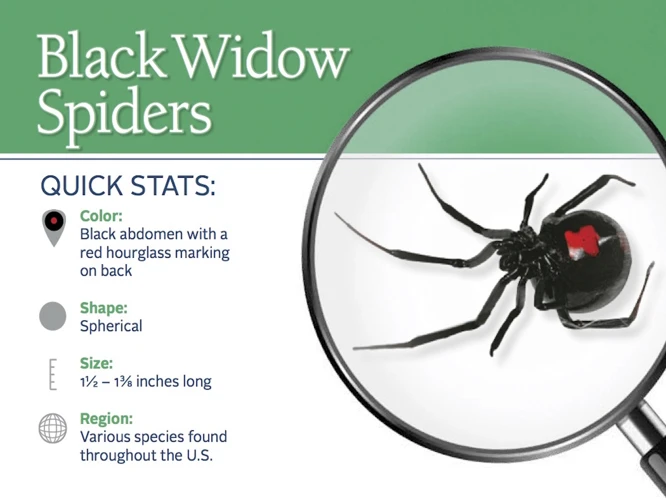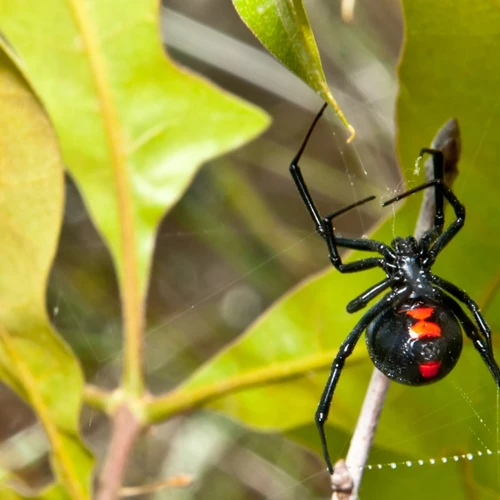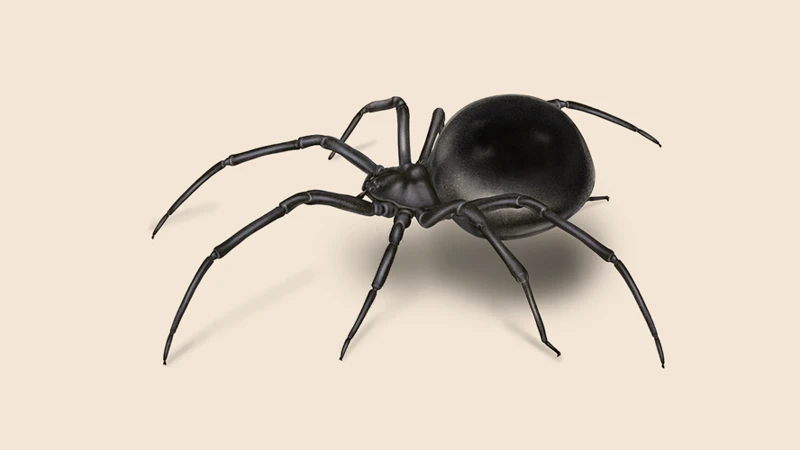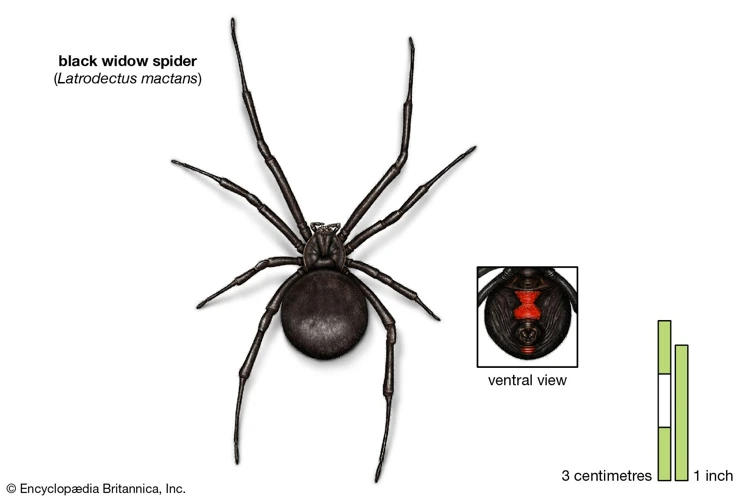As you go about your day, encountering different varieties of spiders is inevitable. One species that demands particular attention is the black widow spider. Known for its venomous bite, these spiders are found in different parts of the world and can cause severe harm to humans and animals alike. It is essential to identify them correctly to avoid potential danger. In this article, we’ll take a complete look at the identifying markings, physical characteristics, and behaviors of black widow spiders. By the end, you’ll be equipped with all the information you need about these eight-legged creatures. So, let’s dive in and explore all there is to know about black widow spiders!
Physical Characteristics of Black Widow Spiders

Black Widow Spiders are well-known for their venomous bite and distinct appearance. Their distinguishing features make them easily recognizable to most people. In this section, we will explore the unique physical characteristics of black widow spiders. From their hourglass shape to their size and coloration, we will take a closer look at what sets these arachnids apart from other spider species. Understanding the physical traits of black widow spiders is important for identification, prevention, and treatment of bites.
Distinctive Hourglass Shape
One of the most distinctive identifying markings of the black widow spider is its hourglass shape, which can be seen on the spider’s abdomen. This marking is a bright, vivid red, which sharply contrasts with the spider’s jet black coloring. It is important to note that not all black widow spiders have an hourglass shape, as certain species can have markings that resemble other shapes or patterns.
The hourglass shape on the black widow spider is actually a marking that indicates that the spider is female, as male black widow spiders do not have this distinctive marking. The hourglass can also vary in shape depending on the species of black widow. Some hourglasses are full and round, while others are more hourglass-shaped in appearance.
Interestingly, the size and shape of the hourglass on a black widow spider can be an indicator of its age. As female black widow spiders mature, the hourglass shape may become more faded and less distinct. This is due to changes in the spider’s exoskeleton, which can affect the appearance of its markings. However, even with a faded hourglass, the black widow spider can still be identified by its other physical characteristics.
To protect themselves from predators and prey, black widow spiders have a number of unique adaptations, such as their silk-spinning abilities and venom glands. Understanding the physical characteristics and behaviors of these spiders is important for identifying and preventing bites. For more information on black widow spider traits and classification, please check out this guide.
Jet Black Coloration
One distinctive physical characteristic that makes black widow spiders easily identifiable is their jet black coloration. Adult female black widow spiders are usually shiny black, while adult males and juveniles can sometimes have lighter markings on their bodies.
To fully understand the black coloration of the black widow spider, it’s important to know that spiders have a tough outer layer called an exoskeleton, which protects their soft inner body parts. The exoskeleton of the black widow spider contains pigments called melanins, which give the spider its black coloration.
Black widow spiders have evolved to have this dark coloration for a number of reasons. Firstly, the black color acts as a camouflage, helping the spider blend in with its surroundings and hide from potential predators. Secondly, the black color helps to absorb heat from the sun, which is particularly useful for spiders living in cooler environments.
It’s worth noting that the black coloration of a black widow spider can sometimes be difficult to see, especially in low-light situations or on dark surfaces. This is why it’s important to look out for other identifying characteristics, such as the distinctive hourglass shape on the spider’s abdomen.
| Key Points | Details |
|---|---|
| Main color | Jet black |
| Other markings | May have lighter markings or spots on body |
| Exoskeleton pigments | Melanins |
| Camouflage | Black color helps spider blend in with surroundings |
| Heat absorption | Black color helps spider absorb heat from sun |
| Visibility | May be difficult to see in low-light situations or on dark surfaces |
Understanding the physical characteristics of a black widow spider, including its jet black coloration, can help people to identify these spiders and take appropriate precautions to avoid potential bites.
Size and Body Shape
Black widow spiders are relatively small in size compared to other spider species, with females typically measuring between 1.5 to 1.8 inches long. Males, on the other hand, are significantly smaller – measuring only about 0.75 inches in length. This size difference is one of the ways to distinguish between male and female black widow spiders. Female black widow spiders have a plump, round abdomen, while males have a smaller, elongated abdomen with a distinctive red or orange hourglass marking.
In terms of body shape, black widow spiders have a bulbous, rounded abdomen that is quite distinctive. Their cephalothorax – the front part of the body to which the legs attach – is flattened and slightly wider than the abdomen. Their legs are long and slender, with the front pair being the longest. Black widow spiders are not particularly fast or agile spiders, but they are known for their silky webs and their venomous bite, which they use to catch prey and defend themselves against predators.
Interestingly, juvenile black widow spiders look quite different from their adult counterparts. They are typically lighter in color, with white or yellow stripes on their backs instead of the iconic red hourglass mark. Juveniles are also smaller and more delicate than adult black widow spiders, which can make them harder to spot in the wild.
Black widow spiders have a distinctive body shape and size that sets them apart from other spider species. Their small size, rounded abdomen, and long legs make them instantly recognizable, even from a distance. If you want to learn more about the unique characteristics of black widow spiders, you can check out our article on size differences between black widows.
Where to Find Black Widow Spiders

Where Black Widow Spiders are Typically Found
Black widow spiders are found in many parts of the world, but they are most common in warm, dry environments. They are often found in dark corners, crevices, and secluded areas, including basements, garages, sheds, and wood piles. Despite their stealthy nature, black widow spiders can be found in different environments and habitats. In this section, we will explore where black widow spiders usually reside and what types of places you should be aware of to avoid spider encounters.
Habitat and Geographic Range
Black widow spiders have a wide range of habitat and geographical distribution. They can be found in a variety of locations, from temperate to tropical climates, and in both urban and rural areas. These spiders are most commonly found in the southern and western parts of the United States, as well as in Central and South America.
| Type of habitat | Specific locations |
|---|---|
| Deserts | Sonoran, Mojave, and Chihuahuan deserts in North America; Atacama and Monte deserts in South America |
| Forests | Southern pine forests, deciduous forests, and mixed forests in the United States and Central America; Amazon rainforest in South America |
| Wetlands | Swamps, marshes, and bogs in the southeastern United States; freshwater wetlands in South America |
| Urban areas | Residential and commercial buildings, outdoor storage areas, and abandoned structures in cities and towns throughout the black widow spider’s range |
Despite their adaptability to different environments and habitats, black widow spiders tend to prefer areas with ample shelter and prey. They are often found in places with limited human activity, such as abandoned buildings or outdoor storage areas. However, they can also be found in homes, garages, and other indoor spaces, especially in areas with clutter and debris.
It is important to note that the range and habits of black widow spiders can vary based on species. For example, the Southern black widow tends to inhabit warmer and more humid environments, while the Northern black widow prefers cooler and drier areas. Additionally, the range and behavior of black widow spiders may shift with changes in climate and urbanization patterns.
If you want to learn more about black widow spider’s prey catch check our Black Widow Spiders Prey Catch article.
Preferred Nesting Locations
Black Widow Spiders prefer nesting in dark, secluded areas where they can build their webs undisturbed. They tend to favor outdoor spaces such as sheds, garages, wood piles, and cluttered areas in which they can easily hide. Black Widow Spiders are also known to create webs in outdoor furniture, play equipment, and under eaves.
Indoors, Black Widow Spiders can be found anywhere from basements to attics, as long as they have access to dark and secluded spaces. They can often be found in cardboard boxes or in cluttered areas that provide coverage, such as piles of clothing or stacks of paper.
It’s important to note that Black Widow Spiders are attracted to locations where their prey, such as flies and other insects, are abundant. Areas with a lot of insect activity, such as near outdoor lights, may also be attractive to Black Widow Spiders.
It is recommended to regularly inspect and clean areas in and around the home to prevent Black Widow Spiders from nesting and reproducing. This can include decluttering storage areas, sealing cracks in walls and foundations, and minimizing the use of outdoor lighting. By removing potential nesting sites and reducing the availability of prey, homeowners can avoid attracting Black Widow Spiders to their property.
To learn more about the physical characteristics and behaviors of Black Widow Spiders, check out our articles on spider body types comparison, juvenile Black Widow Spider traits, and adaptability in Black Widow Spiders. And for information on the unique properties of Black Widow Spider silk and hairs, as well as their venom, visit black widow spider silk uses, black widow spider hairs functions, and black widow venom glands. You can also learn about how the Black Widow Spider exoskeleton protects them from predators in our article: Black Widow Spider Exoskeleton Protects.
Signs of Black Widow Spider Presence

If you’re concerned about the presence of black widow spiders in your area, there are a few signs you should be on the lookout for. These spiders are known for their distinctive markings and can be dangerous if provoked. Keep an eye out for webs and egg sacs, spider sightings, and be aware of the symptoms of black widow spider bites. In this section, we’ll go over each of these signs in more detail so you can stay informed and take the necessary precautions to stay safe.
Webs and Egg Sacs
Black widow spiders are known for spinning webs that are irregularly shaped and dense. Their webs are distinguishable by their strong, silky texture, and they are typically located near ground level. The webs are usually inconspicuous and may be difficult to detect, so it’s essential to be cautious and avoid touching or disturbing them.
Black widow spiders also produce distinctive egg sacs, which are smooth, round structures with a papery texture. The egg sacs are usually beige or tan in color and may be up to 3/4 inch in diameter. These sacs are often attached close to the web, and they contain dozens of eggs.
It’s important to remember that the presence of black widow webs and egg sacs is not a definitive sign that the spiders themselves are nearby. However, it is a good indication that they may be inhabiting the immediate area. If you notice webs or egg sacs close to your home, you should exercise caution and take appropriate measures to prevent contact with these spiders.
Here are some tips for dealing with black widow spider webs and egg sacs:
- Wear gloves and long-sleeved clothing if you must work in an area where black widows may be present.
- If you see a web or egg sac, avoid touching it.
- If a web or egg sac is in a high-traffic area, use a broom or stick to carefully remove it and dispose of it in a sealed plastic bag or container.
- Regularly inspect areas around your property, and remove any webs or egg sacs that you find.
- If you frequently find webs or egg sacs around your property, consider hiring a professional pest control service to help manage the infestation.
By being aware of the signs of black widow spider presence, you can take proactive steps to ensure your safety and minimize the risk of encountering these venomous spiders.
Spider Sightings
One of the most obvious signs of black widow spiders is a sighting of the spider itself. However, identifying a black widow can be difficult for those who are unfamiliar with the species. Here are some key things to look for when trying to identify a black widow spider sighted in the wild or in and around your home:
- Distinctive Markings: Look for the black widow’s distinctive hourglass shape on the underside of its abdomen. This hourglass mark is typically a bright red or orange color that stands out against the spider’s jet black body.
- Size: Black widow spiders are relatively small compared to other spider species, with females typically measuring between 1.5 and 1.8 inches in length, and males being slightly smaller. If you see a small, black spider with long legs and a noticeable hourglass shape, there is a good chance that it could be a black widow.
- Web: Black widows are known for their messy, disorganized webs, which may be found in dark corners, in between objects, or in cluttered areas both inside and outside the home. If you see a web with a tangled mess of silk, and spider remains scattered throughout, there is a possibility that it is a black widow’s web.
- Behavior: Black widows are typically shy and only bite when defending their eggs or territory. However, if you observe a spider that is aggressive or has a tendency to scuttle quickly away when approached, it could be a black widow.
If you spot a spider that you think might be a black widow, it is best to leave it alone and contact a professional pest control service to assess and remove the spider if necessary. Remember, black widow spider bites are rare, but can be dangerous if left untreated. Keeping your home and yard tidy and free of clutter can help reduce the risk of attracting black widows and other dangerous spiders.
Symptoms of Black Widow Spider Bites
A bite from a black widow spider can cause a variety of symptoms that may vary depending on the victim’s age, health, and the amount of venom injected. Here are some common symptoms to watch out for:
- Immediate Pain: The bite itself is usually painful and may cause a burning sensation at first.
- Redness and Swelling: The bite area may become swollen and red in color.
- Muscle Cramps: As the venom spreads through the body, muscle cramps can develop, typically starting in the abdomen and spreading to the back, thigh, and upper arm. The cramps can be intense and accompanied by muscle spasms.
- Sweating: The victim may experience profuse sweating, particularly in the affected limb area.
- Nausea and Vomiting: In some cases, victims may also feel nauseous and experience vomiting.
- Difficulty Breathing: The venom can cause respiratory problems in severe cases, leading to shortness of breath and difficulty breathing.
- High Blood Pressure: Black widow spider venom can cause elevated blood pressure, which can result in heart palpitations and a rapid heartbeat.
- Headaches: Some individuals may experience a headache or migraine-like symptoms.
It is important to note that not all black widow bites will result in all of these symptoms, and not everyone reacts to the venom in the same way. However, if a person experiences any combination of these symptoms after being bit by a black widow spider, they should seek immediate medical attention. In severe cases, black widow spider bites can be fatal, particularly in young children, the elderly, and those with weakened immune systems.
Preventing Black Widow Spider Bites
When it comes to venomous spiders, the black widow spider is one of the most notorious. Though their bites are rarely fatal, they can cause serious pain and discomfort. Thankfully, there are steps you can take to prevent black widow spider bites. By being mindful of your surroundings and taking a few precautions, you can reduce your risk of encountering these dangerous arachnids. Let’s take a closer look at some of the strategies you can use to keep yourself and your loved ones safe.
Sealing Entry Points into Homes and Buildings
One of the most effective ways to prevent black widow spider bites is to take measures to keep them out of your home or building. To do this, it is important to seal any entry points that may allow spiders to gain access. This can include gaps around doors, windows, and vents, as well as cracks in walls and the foundation. Here are some steps to take for sealing these entry points:
- Inspect your home or building for any gaps or cracks that may provide entry points for spiders. Common entry points include gaps around doors, windows, and vents, as well as cracks in walls and the foundation.
- Seal any gaps or cracks with caulk or weather stripping to prevent spiders from entering. Be sure to seal both the inside and outside of the entry point for maximum effectiveness.
- Install door sweeps on exterior doors to prevent spiders from crawling underneath them.
- Make sure all screens on windows and doors are free of holes and tears to prevent spiders from gaining entry.
- Consider installing mesh screens on vents to prevent spiders from entering through them.
By taking these steps to seal entry points into your home or building, you can greatly reduce the chances of encountering a black widow spider and prevent painful and potentially dangerous bites.
Minimizing Spider-Friendly Clutter
One of the ways that you can prevent black widow spider bites is to minimize clutter in your indoor and outdoor spaces. Black widow spiders like to hide and breed in cluttered areas, so eliminating these areas can help reduce their presence on your property. Here are some steps you can take to minimize spider-friendly clutter:
- Remove piles of debris: Black widows like to breed in piles of debris, such as firewood, leaves, and garbage. Removing these piles from your property can help reduce their presence.
- Organize stored items: Cluttered storage areas, such as basements and garages, can provide excellent hiding places for black widows. Organize these areas to eliminate clutter and reduce the number of hiding spots available to spiders.
- Clean up outdoor areas: Overgrown lawn and garden areas can also provide cover for black widows. Keep your lawn and garden well-manicured to reduce the number of hiding places for spiders.
- Eliminate unnecessary outdoor clutter: Outdoor clutter such as old furniture, piles of lumber or building materials, and discarded equipment can all provide hiding places for black widows. Get rid of these items to reduce the number of spider-friendly areas on your property.
Taking these steps to minimize spider-friendly clutter can help reduce the likelihood of black widow spiders taking up residence on your property. By eliminating hiding places and breeding areas, you can create a less hospitable environment for these venomous spiders.
Wearing Gloves and Long Sleeves When Working Outside
When spending time outside, it’s important to take precautions to reduce the risk of encountering black widow spiders. One effective preventative measure is to wear protective clothing such as gloves and long sleeves.
Here are some tips to keep in mind when choosing protective clothing:
- Wear sturdy gloves: When working outside, consider wearing sturdy gloves made of thick material to protect your hands from spider bites. Gloves with a tight-fitting cuff can help prevent spiders from crawling up your sleeves.
- Choose long-sleeved shirts: Wearing long-sleeved shirts can help protect your arms from spider bites. Tuck your shirt into your pants to prevent spiders from crawling up.
- Wear light-colored clothing: Black widow spiders are less likely to be attracted to light-colored clothing, so consider wearing light colors if you know you’ll be in an area where black widows are common.
- Inspect clothing before wearing: Before putting on gloves or clothing that has been stored in an area where black widows might be present, inspect it carefully for signs of spiders or egg sacs. Shake out clothing or gloves before putting them on.
By taking these precautions and wearing the appropriate clothing, you can greatly reduce your risk of encountering black widow spiders while working outside.
Conclusion
In conclusion, black widow spiders can be a cause for concern due to their potentially dangerous bites. It’s important to be able to identify these spiders and know the signs of their presence in order to prevent bites from occurring. Remember, the distinctive hourglass marking on their abdomen is the most recognizable feature of black widow spiders, but their shiny black color and overall body shape are also key identifying factors.
Knowing where to find black widows and their preferred nesting locations can help you avoid them. Regularly cleaning up clutter and sealing entry points into your home or building can also go a long way in preventing spider infestations. If you do come across a black widow or their web, it’s best to call a professional to handle its removal.
By taking the necessary precautions and staying informed about black widow spiders, you can help keep yourself and your loved ones safe from their potentially harmful bites. Remember to always wear protective clothing when working outdoors and to seek medical attention if you suspect you have been bitten by a black widow spider. Stay vigilant and stay safe!
Frequently Asked Questions
What is the identifying feature of black widow spiders?
The most distinctive identifying feature of black widow spiders is the red hourglass marking on the underside of their abdomen.
Are black widow spiders venomous?
Yes, black widow spiders are venomous. Their venom is a neurotoxin that affects the nervous system.
What is the color of black widow spiders?
Black widow spiders have jet black coloration.
How big are black widow spiders?
Adult female black widow spiders can grow to be up to 1.5 inches long, including their legs.
Where do black widow spiders live?
Black widow spiders are found throughout the world, but they prefer warm, dry climates. They can be found living in outdoor spaces such as wood piles, under rocks, and in abandoned animal burrows.
What do black widow spiders eat?
Black widow spiders primarily feed on insects, but they have been known to eat small reptiles and amphibians.
What should you do if you are bitten by a black widow spider?
If you are bitten by a black widow spider, seek medical attention immediately. Symptoms of a black widow spider bite include muscle pain, cramps, spasms, and sweating.
How can you prevent black widow spider bites?
To prevent black widow spider bites, seal entry points into homes and buildings, minimize spider-friendly clutter, and wear gloves and long sleeves when working outside.
Are black widow spiders aggressive?
Black widow spiders are not typically aggressive towards humans. They will only bite if they feel threatened or provoked.
Do all female black widow spiders have a red hourglass marking?
No, not all female black widow spiders have the red hourglass marking. Some species have different markings, such as a red spot or no marking at all.






